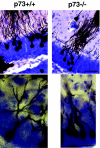p73: a multifunctional protein in neurobiology
- PMID: 21380933
- PMCID: PMC3062774
- DOI: 10.1007/s12035-011-8172-6
p73: a multifunctional protein in neurobiology
Abstract
p73, a transcription factor of the p53 family, plays a key role in many biological processes including neuronal development. Indeed, mice deficient for both TAp73 and ΔNp73 isoforms display neuronal pathologies, including hydrocephalus and hippocampal dysgenesis, with defects in the CA1-CA3 pyramidal cell layers and the dentate gyrus. TAp73 expression increases in parallel with neuronal differentiation and its ectopic expression induces neurite outgrowth and expression of neuronal markers in neuroblastoma cell lines and neural stem cells, suggesting that it has a pro-differentiation role. In contrast, ΔNp73 shows a survival function in mature cortical neurons as selective ΔNp73 null mice have reduced cortical thickness. Recent evidence has also suggested that p73 isoforms are deregulated in neurodegenerative pathologies such as Alzheimer's disease, with abnormal tau phosphorylation. Thus, in addition to its increasingly accepted contribution to tumorigenesis, the p73 subfamily also plays a role in neuronal development and neurodegeneration.
Figures




References
-
- Muller M, Schilling T, Sayan AE, Kairat A, Lorenz K, Schulze-Bergkamen H, Oren M, Koch A, Tannapfel A, Stremmel W, Melino G, Krammer PH. TAp73/Delta Np73 influences apoptotic response, chemosensitivity and prognosis in hepatocellular carcinoma. Cell Death Differ. 2005;12:1564–1577. doi: 10.1038/sj.cdd.4401774. - DOI - PubMed
Publication types
MeSH terms
Substances
Grants and funding
LinkOut - more resources
Full Text Sources
Research Materials
Miscellaneous

